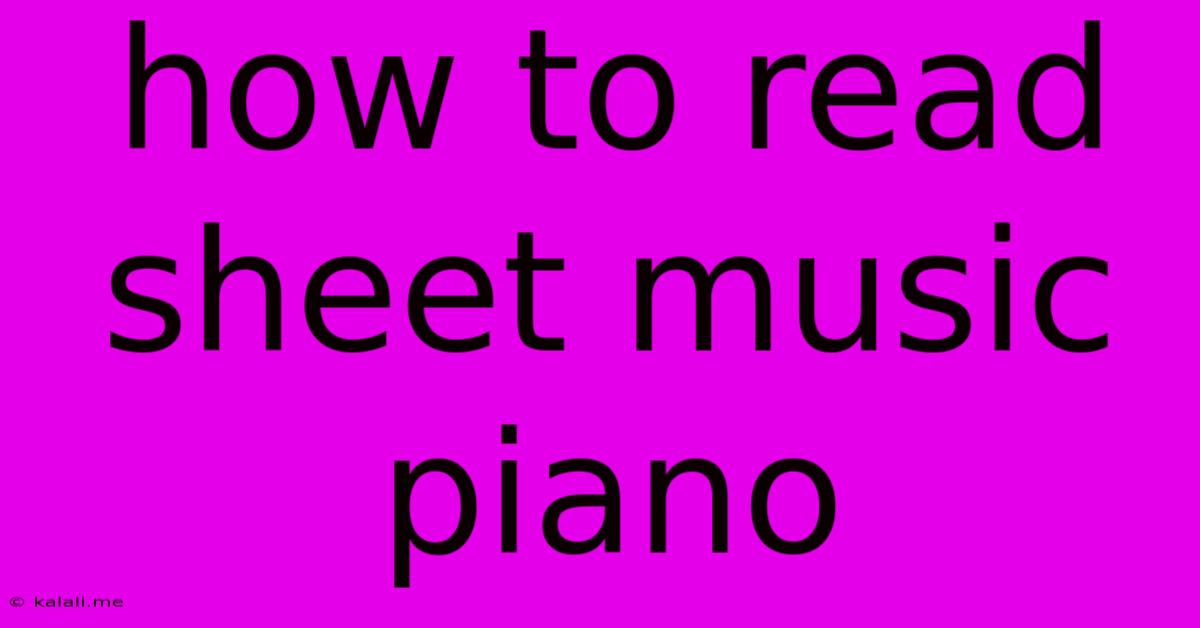How To Read Sheet Music Piano
Kalali
May 26, 2025 · 3 min read

Table of Contents
How to Read Sheet Music for Piano: A Beginner's Guide
Learning to read sheet music for piano can seem daunting at first, but with consistent practice and the right approach, it becomes an incredibly rewarding skill. This guide breaks down the essentials, helping you decipher those musical symbols and unlock the world of piano playing. This article covers the basics of reading treble and bass clef, understanding rhythm, and interpreting musical notation. By the end, you'll be well on your way to playing your favorite pieces from sheet music.
Understanding the Staff and Clefs
Piano music uses a system of two staves: the treble clef and the bass clef. The treble clef, shaped like a stylized "G," sits on the second line from the bottom, indicating the notes on the higher register. The bass clef, resembling a backwards "C," sits on the fourth line from the bottom, representing the lower register. Each line and space on the staff represents a specific note.
- Treble Clef: Memorize the notes on the lines (E-G-B-D-F) using the mnemonic "Every Good Boy Deserves Fudge." The spaces spell "FACE."
- Bass Clef: The lines represent (G-B-D-F-A) using the mnemonic "Good Boys Do Fine Always." The spaces spell "ACEG."
Recognizing Note Values and Rhythms
Understanding note values is crucial for playing music accurately. Each note represents a specific duration of sound. Common note values include:
- Whole Note (♩): Four beats
- Half Note (♩): Two beats
- Quarter Note (♩): One beat
- Eighth Note (♩): Half a beat (often written with a flag)
- Sixteenth Note (♩): Quarter of a beat (often written with two flags)
The time signature, a fraction located at the beginning of a piece, indicates how many beats are in each measure (the top number) and which note value receives one beat (the bottom number). For example, a 4/4 time signature means four beats per measure, and a quarter note gets one beat.
Interpreting Dynamics and Articulation
Sheet music doesn't just tell you what notes to play, but also how to play them. Dynamics indicate the volume, while articulation specifies how the notes should sound.
- Dynamics: piano (soft), mezzo piano (moderately soft), mezzo forte (moderately loud), forte (loud), fortissimo (very loud), and their abbreviations (p, mp, mf, f, ff). crescendo (gradually getting louder) and diminuendo (gradually getting softer) are also important dynamic markings.
- Articulation: legato (smooth and connected), staccato (short and detached), and other markings that dictate phrasing and expression.
Putting It All Together: A Simple Exercise
Start with simple pieces in C major, which only use white keys. Practice reading the notes on the staff, counting the beats, and paying attention to the dynamics and articulation. Gradually increase the complexity of the music as your skills improve. Don't be afraid to break down a piece into smaller sections, focusing on mastering one part at a time. Use online resources, such as interactive sheet music websites and YouTube tutorials, to supplement your learning.
Practice and Patience: The Key to Success
Learning to read sheet music takes time and dedication. Regular practice, even if it's just for a short period each day, is essential. Be patient with yourself and celebrate your progress along the way. With perseverance, you'll soon be able to read and play piano music with confidence and enjoyment. Remember to utilize online resources and consider working with a piano teacher for personalized guidance and support. The journey of learning to read music is a rewarding one – enjoy the process!
Latest Posts
Latest Posts
-
Mcgonnagall Asking About Leaving Harry With Muggles
May 27, 2025
-
How Long Can You Keep A Fresh Turkey In Refrigerator
May 27, 2025
-
Can I See A Doctor Without Photo Id
May 27, 2025
-
How To Clean Up Battery Acid
May 27, 2025
-
How To Remove Screw With Stripped Head
May 27, 2025
Related Post
Thank you for visiting our website which covers about How To Read Sheet Music Piano . We hope the information provided has been useful to you. Feel free to contact us if you have any questions or need further assistance. See you next time and don't miss to bookmark.